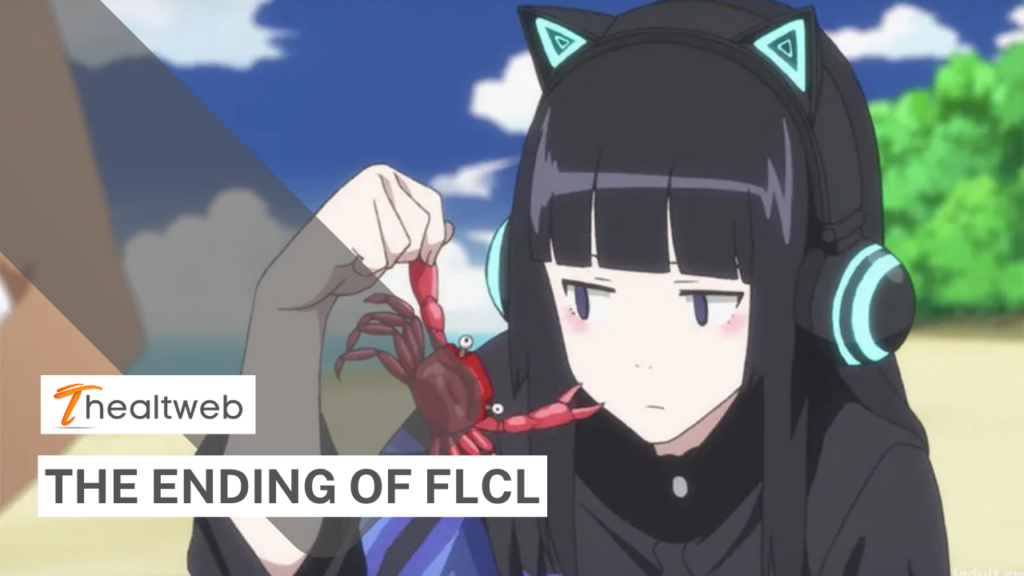Popular Japanese animation FLCL, which debuted in 2000, is a far cry from the Studio Ghibli universe. The 12-year-old protagonist of the Tsurumaki Kazuya and Enokido Yji-created and -directed television series, Naota, is run over by Haruko, a lady who is later revealed to be an extraterrestrial while riding on her Vespa. Haruko then smashes Naota in the head with her blue Rickenbacker 4001 guitar.
After the impact, Naota develops a big horn sticking out of his forehead, and things only grow crazier as robots emerge from the horn to engage in combat, Haruko pursues the formidable Pirate King, and a massive iron tries to destroy Earth.
The Lie of Relationships in FLCL
Related – The Ending Of Crimson Peak – EXPLAINED!
The development of FLCL and Naota in adults
Naota’s passage to maturity is the main theme of FLCL as Haruko meddles in his life. She makes the assertion that she is an investigator with the Galactic Space Patrol Brotherhood, dispatched to retrieve Atomsk from the enigmatic Medical Mechanica organization. Her true objective has always been to ingest Atomsk and become his. The nice robot Canti, which emerges from Naota’s horn, becomes Haruko and Naota’s ally.
Then, Haruko draws Atomsk out using Naota’s gullibility and the portal abilities of his horn. She intends to absorb Naota herself, but she is prevented from doing so when Atomsk accepts him as a host. Atomsk ultimately succeeds in escaping, and Haruko departs Earth to continue her pursuit of him.
While all of this is going on, Naota is only dealing with the issues that a 12-year-old boy faces on a daily basis. For Naota to lose his innocence and maturity, the anime uses a lot of overtly sexual references. Over the course of the first six episodes, Naota is duped by all the grownups in his life, particularly Haruko, who takes advantage of his love.
FLCL Alternative and FLCL Progressive
Adult Swim collaborated with Production I.G., original character designer Yoshiyuki Sadamato, and FLCL creator Tsurumaki in a supervisory capacity to develop two new seasons of FLCL in 2018, dubbed FLCL Progressive and FLCL Alternative. This was done 18 years after the first season aired. The common thread throughout the two seasons’ tales is Haruko and her mission.
Years after the journey of Haruko and Naota, the new episodes take place.
The main character of FLCL Progressive is Hidomi, a 14-year-old girl who wears headphones nonstop. She has a very typical existence up until the day Julia runs her over. There’s no preventing the turmoil from arriving in her town when you combine this with a mysterious new teacher at her school named Haruko. It comes out that Julia is actually a piece of Haruko that has broken off.
Julia wants to see the Pirate King released, while Haruko wants to catch and fall in love with Atomsk. Haruko also needs Hidomi’s assistance to fight Medical Mechanica, the organization that is still attempting to destroy Earth. Hidomi learns more about her abilities during the season while also growing fond of her classmate Ide, who has a great crush on her.
The meaning of FLCL and the legacy of the program
The most significant contribution FLCL has made to anime and TV, in general, is the way it employs bizarre visuals to tell a moving tale of love and maturation.
Even while FLCL has a tonne of wonderful symbolism over the seasons, its first run is where it really shines. There are many sexual innuendos thanks to Naota’s horn, Haruko’s guitar, and a tonne of other imagery. There’s little doubt that this anime series is intended for an older audience. Canti, Naota’s robot companion, is a symbol of Naota’s American-based older brother Tasuku. He is the ideal role model for an adult in Naota’s eyes. Canti is a figure who is meant to be reassuring and non-threatening, and he acts like a protective parent.
Related – The Ending Of Now You See Me – EXPLAINED!
Reddit user Rfowl009 goes into great length regarding the symbolism they discovered in FLCL in a thorough thread. They emphasize Naota’s journey through puberty as she tries to comprehend the perplexing ideas of sexuality and adulthood, which is often cited as FLCL’s central topic.
It’s reasonable to conclude that despite all of this study, FLCL’s three seasons remain a mystery that many viewers will find difficult to comprehend. Fortunately, a lot of fans say that watching the series again really helps you understand the major plot involving Atomsk and Medical Mechanica as well as the individual adventures of Naota, Haruko, and the other characters.

